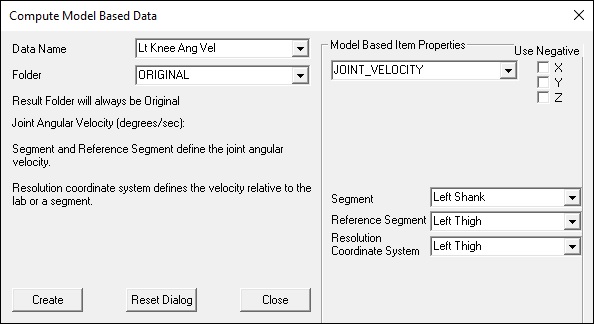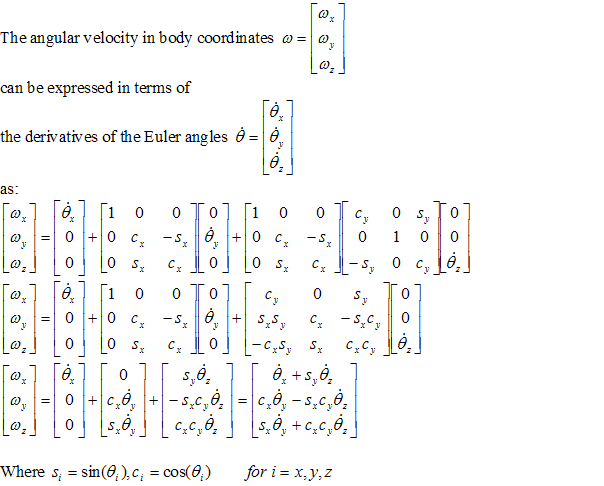Model Based Item: JOINT VELOCITY: Joint Angular Velocity
| Language: | English • français • italiano • português • español |
|---|
The joint angular velocity is a vector that describes the relative angular velocity of one segment relative to another segment.
The Joint Angular Velocity can be a bit troublesome to interpret unless you recognize that the signal is not the same as the derivative of the Joint Angle. It is possible that the some terms of the Joint Angular Velocity are not consistent with the derivative of the Joint Angle.
Resolution Coordinate System
It is not obvious to many people why there is a reference coordinate system and a resolution coordinate system.
The reference coordinate system is straightforward because the joint angular velocity is the rate of change of one segment coordinate system relative to another segment coordinate system. In addition the use of the term reference segment instead of reference coordinate system makes the meaning obvious.
The resolution coordinate system refers to the coordinate system in which the angular velocity vector is expressed. This is often, but not always, the same as the reference coordinate system.
For example, if you want to compare a Joint Angle and a Joint Angular Velocity of the same two segment and reference segment, you cannot use only one representation of the joint angular velocity. This is because the Joint Angular Velocity is a vector and the Joint Angle is not.
Consider a Knee Angle defined as the shank relative to the thigh with a Cardan Angle consistent with the Joint Coordinate System of Grood and Suntay.
The joint angle is interpreted as:
- rotation about the x-axis of the thigh segment coordinate system
- rotation about the z-axis of the shank segment coordinate system
- rotation about an axis perpendicular to the other two axes.
To compare the joint angular velocity and joint angle you need to create two joint angular velocity signals.
- One resolved into the the reference segment coordinate system
- One resolved in the segment coordinate system.
- The x-component of the joint angle has an x-axis consistent with the angular velocity resolved into the reference coordinate system
- The z-component of the joint angle has a z-axis consistent with the angular velocity resolved in the segment coordinate system
and only for small values of the y-component can there be a comparison of either angular velocity.
Joint Angles and Joint Angular Velocities
It is certainly confusing conceptually to compare the components of joint angles and joint angular velocities, because it isn't intuitively obvious that you are trying to compare "apples and oranges".
If you consider the joint angle to be described as Segment1 (e.g. Segment) relative to Segment2 (e.g. Reference Segment) using an XYZ Cardan sequence (e.g. the Joint Coordinate System of Grood & Suntay).
It is only possible to find a comparison between the X-component and the Z-component of the angle with an angular velocity, and oddly enough it is actually two different angular velocities.
The x-component can be compared with the x-component of a joint angular velocity resolved into Segment2, and the z-component of a joint angular velocity resolved into segment1
The second component of the joint angle cannot be compared with anything
IK Constraints
This is even more confusing when you are using Inverse Kinematic (Global Optimization) because a joint that is constrained to have degrees of freedom in only the x and z components will have a y-component of the joint angle that is essentially zero (e.g. just noise), but the y-component of the angular velocity is non-zero.
You should not expect the second component to have meaning in the context of the IK constraints, you should resist the temptation to interpret the y-component of the angular velocity in the context of the y- component of the joint angle.
Relationship between the Joint Angular Velocity and the derivative of the Cardan Joint Angles
The Joint Angular Velocity can be a bit troublesome to interpret unless you recognize that the signal is not the same as the derivative of the Joint Angle. It is possible that the some terms of the Joint Angular Velocity are not consistent with the derivative of the Joint Angle.
Euler angles are not vectors, so it isn't possible to compute joint angular velocity by taking the first derivative of the joint angles (e.g. Euler/Cardan angles).
With respect to the default Visual3D convention of an XYZ sequence for the Cardan angle, the joint angular velocity can be expressed in Euler angles using the following

